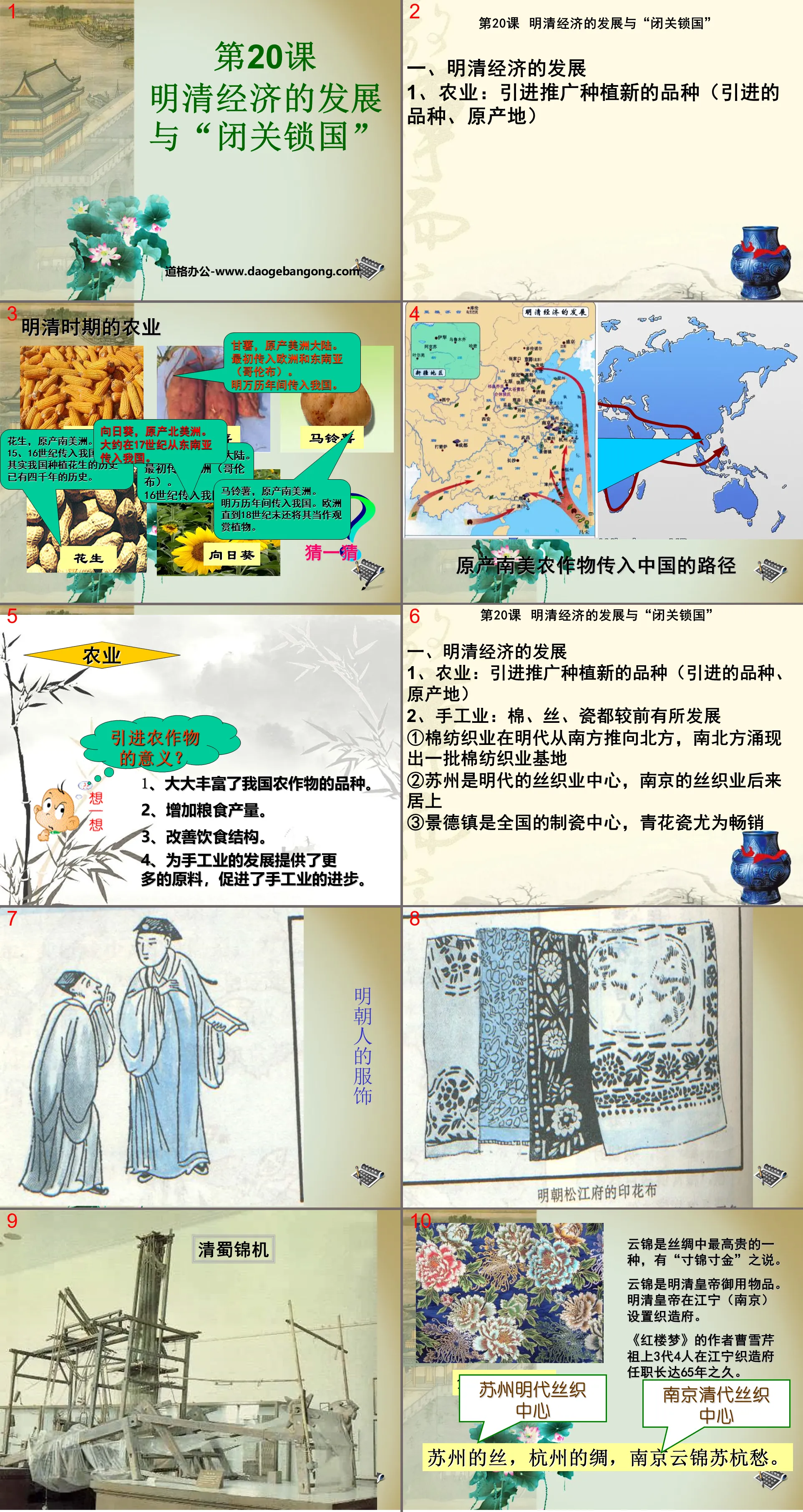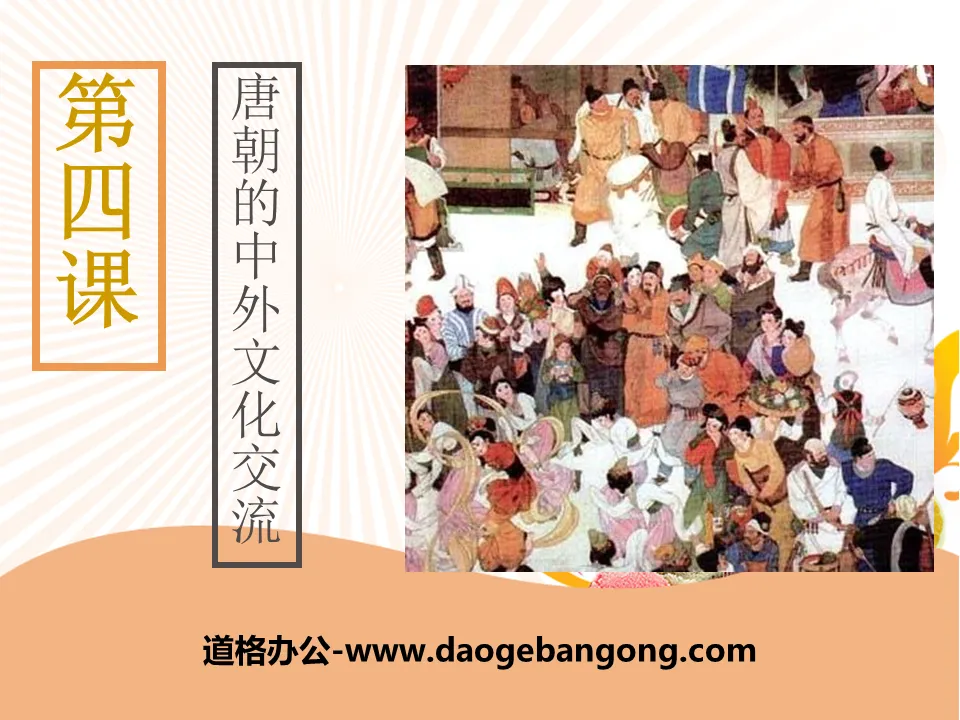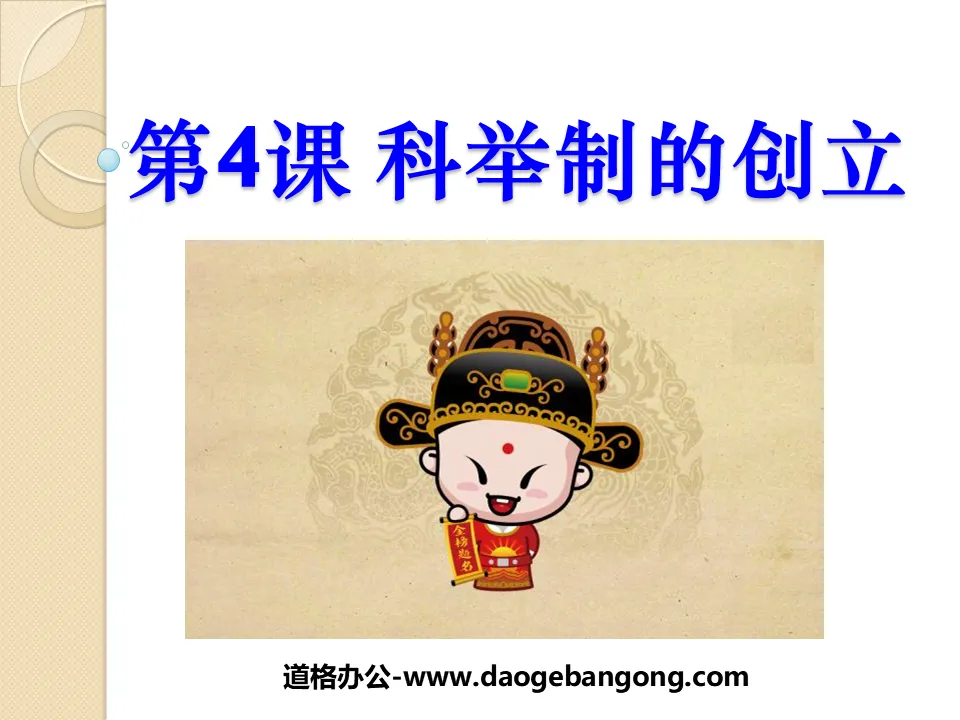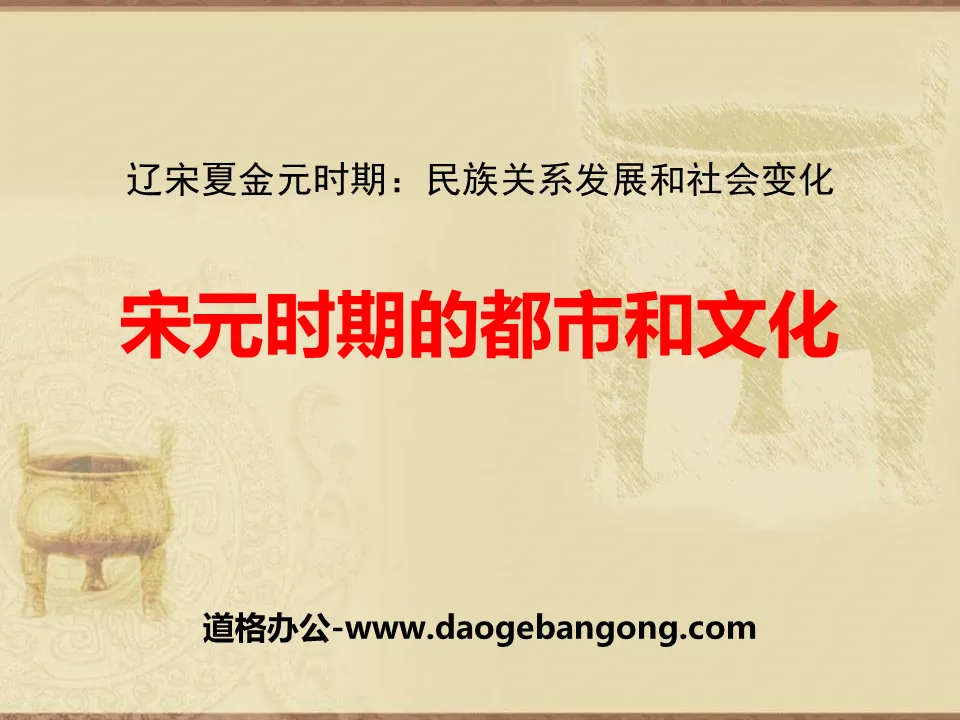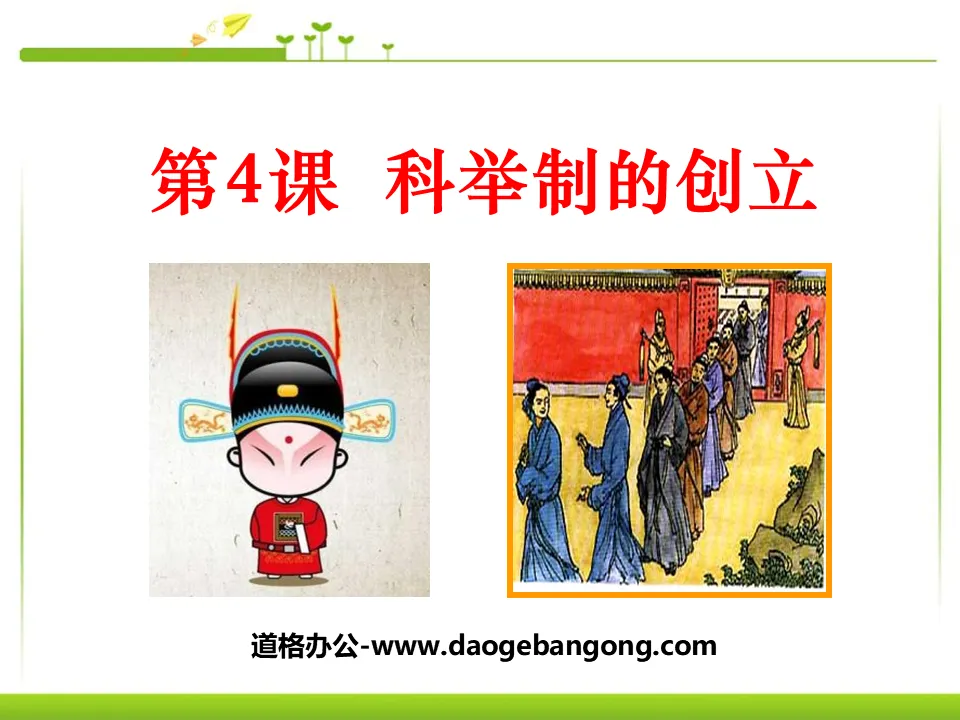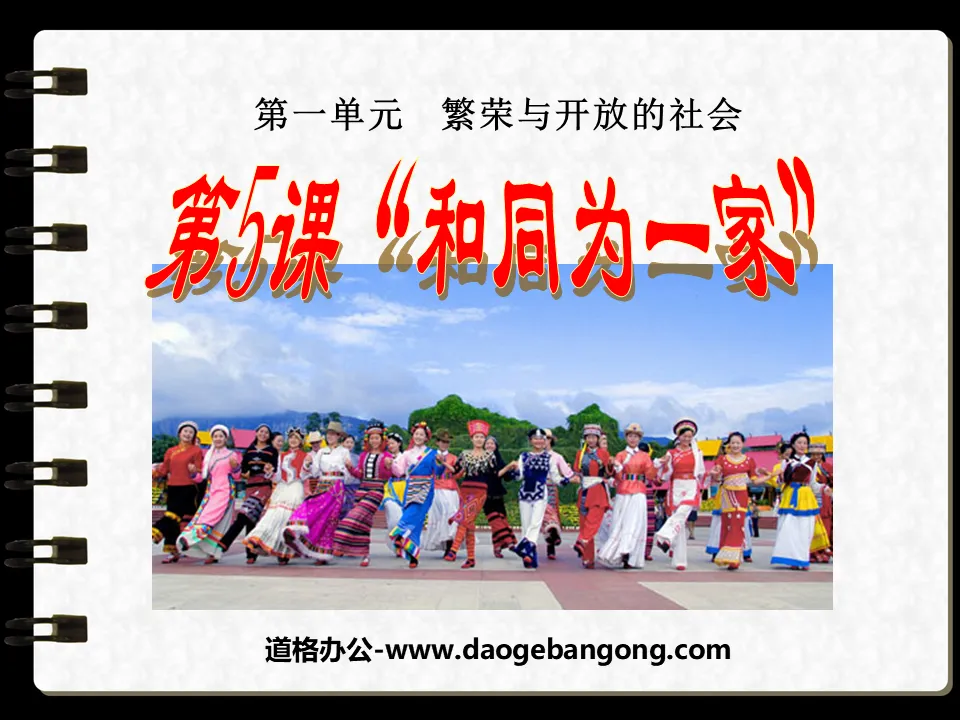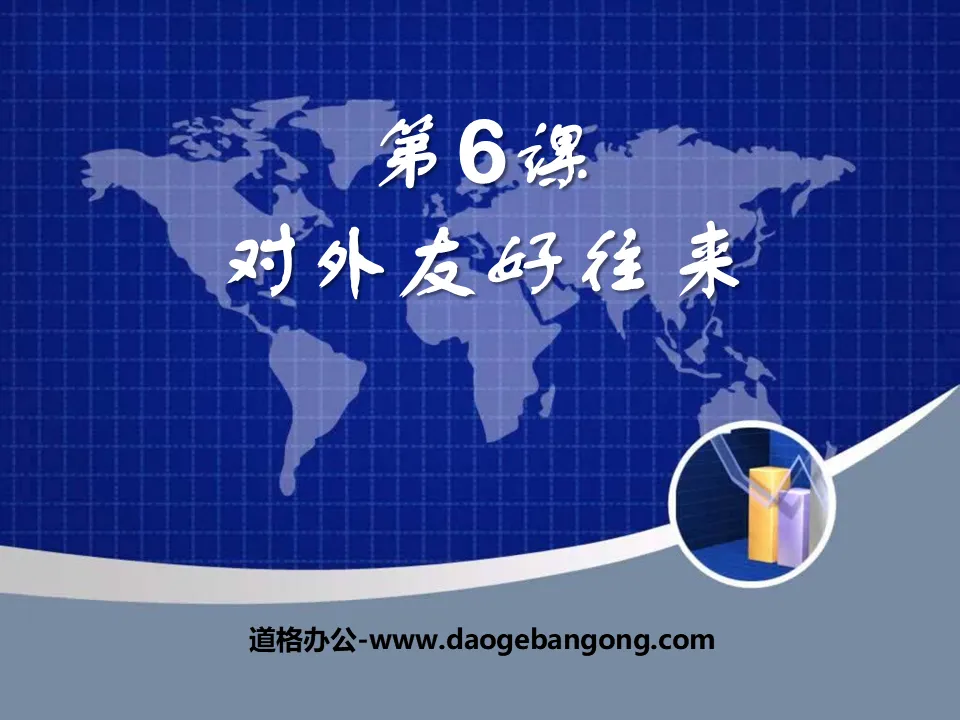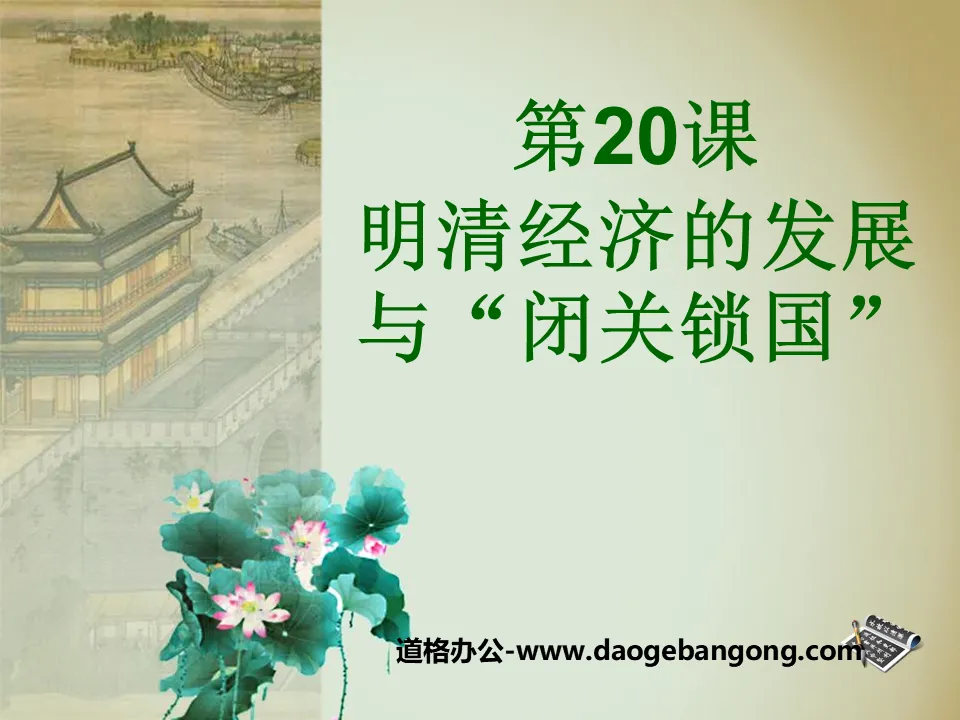
| Category | Format | Size |
|---|---|---|
| People's Education Press Seventh Grade History Volume 2 | pptx | 6 MB |
Description
"Economic Development and Seclusion in the Ming and Qing Dynasties" Consolidation of a Unified Multi-Ethnic Country and Social Crisis PPT Courseware
1. Economic development in the Ming and Qing Dynasties
1. Agriculture: Introduce, promote and plant new varieties (introduced varieties, origin)
Peanuts are native to South America. It was introduced into my country in the 15th and 16th centuries. In fact, peanut cultivation in my country has a history of four thousand years.
Sunflower, native to North America. It was introduced to my country from Southeast Asia around the 17th century.
Potato, native to South America. It was introduced into my country during the Wanli period of the Ming Dynasty. It was still used as an ornamental plant in Europe until the end of the 18th century.
Sweet potato is native to the American continent. Originally introduced to Europe and Southeast Asia (Columbus). It was introduced into my country during the Wanli period of the Ming Dynasty.
What is the significance of introducing crops?
1. Greatly enriched the varieties of crops in our country.
2. Increase food production.
3. Improve dietary structure.
4. Provide more raw materials for the development of handicraft industry and promote the progress of handicraft industry.
2. Handicraft industry: cotton, silk, and porcelain have all developed compared with before
①The cotton textile industry was pushed from the south to the north in the Ming Dynasty, and a number of cotton textile industry bases emerged in the north and south.
②Suzhou was the center of the silk weaving industry in the Ming Dynasty, and Nanjing’s silk weaving industry came from behind.
③Jingdezhen is the porcelain making center in the country, and blue and white porcelain is particularly popular.
Yun brocade is the noblest kind of silk, and it is said that "every inch of brocade is worth every inch."
Yun brocade was a royal item used by the emperors of the Ming and Qing Dynasties. The emperors of the Ming and Qing Dynasties set up a weaving mansion in Jiangning (Nanjing).
Cao Xueqin, the author of "Dream of Red Mansions", had three generations and four ancestors working in Jiangning Zhizao Mansion for 65 years.
3. Commerce: The commodity economy is unprecedentedly active (Beijing, Nanjing)
The Shanxi merchants in Shanxi were a large business group that emerged during the Ming and Qing Dynasties. This group developed by taking advantage of Shanxi's favorable geographical location near the northern border towns. It mainly dealt in salt, silk, grain, ironware, cotton and other military supplies as well as finance. Pawn industry. The scope of activities extends from the Yellow River Basin across the country and as far away as Russia, Japan, Southeast Asia and other regions. It is known as "traveling all over the world". In the middle and late Ming Dynasty, history said: "Those from wealthy families dominated Xin'an in the south of the Yangtze River, and Shanyou in the north of the Yangtze River." Shanxi merchants once dominated the domestic business community for 500 years, and only declined in modern times.
The more than 300 years from the middle of the Ming Dynasty to the end of Qianlong's reign in the Qing Dynasty was the golden age for the development of Huizhou merchants. Regardless of the number of business people, scope of activities, business industries and capital, they ranked first among all merchant groups in the country. At that time, business became the "first-class livelihood" of Huizhou people. Among adult men, business accounted for 70%, and even more in the peak period. The activities of Huizhou merchants spread across urban and rural areas, reaching Huainan in the east, Yunnan, Qian, Guan, and Long in the west, Youyan and Liaodong in the north, and Fujian and Guangdong in the south. Hui merchants also traveled as far as Japan, Siam, Southeast Asian countries and Portugal.
4. The emergence of the buds of capitalist production relations
(1) Time: after the mid-Ming Dynasty
(2) Location: Songjiang, Suzhou and other places
(3) Business form: investment by machine owners and contribution by machine workers
(4) Nature of operation: It is a capitalist production relationship
(5) Development: Development occurred in the early Qing Dynasty
①In the Qing Dynasty, the number of handicraft sectors with capitalist nature increased
②Further expansion of production scale
3. The Qing Dynasty implemented the policy of "closing the country apart"
1. Reason: p118
① Believes that China is rich in products and can be used for everything, so there is no need for economic exchanges with foreign countries
②The rulers of the Qing Dynasty were worried that the country’s territorial sovereignty would be infringed upon by foreign countries.
③Afraid of coastal people interacting with foreigners and endangering their own rule
2. Performance:
① In the 40 years of the Qing Dynasty, a strict maritime ban policy was implemented; after the Qing Dynasty unified Taiwan, it opened four ports as ports for foreign trade.
②Strict restrictions on the types of exported goods and the load capacity of ships going to sea
③Ordered to open only Guangzhou as a foreign trade port and close other ports
3. Impact (consequences):
① Played a certain role in self-defense against the aggressive activities of Western colonists
② The Qing government closed the country and isolated itself from the world. It could neither see changes in the world situation nor learn advanced scientific knowledge and production technology from the West in a timely manner, causing China to gradually fall behind in the world.
1. Among the following things, which one is in the correct order when they were introduced to China ( )
①Corn, sweet potato ②Champa rice ③Hu Xuanwu ④Alfalfa, grape
A. ① ② ④ ③ B. ② ③ ④ ① C. ① ② ③ ④ D. ④ ③ ② ①
2. The origin of peanuts, sunflowers, potatoes and other crops is ( )
A. Western Regions B. Western Ocean C. Eastern Ocean D. South America
3. The area where capitalism sprouted in the middle and late Ming Dynasty appeared in ( )
A. Shanxi region B. Southern Anhui region C. Suzhou and Songjiang regions D. Southeast coast
4. The basis for judging the emergence of capitalism in the middle and late Ming Dynasty is ( )
A. The level of handicraft industry exceeds that of previous generations B. Commodity economy develops and foreign trade expands
C. Increase in handicraft workshops D. The emergence of the production method of employment and employment of "machine households contribute capital and machine workers contribute"
5. The foreign policy of the Qing Dynasty in the early 40 years was ( )
A. Strict sea ban policy, people are not allowed to go to sea for trade without authorization B. The four ports are open to foreign trade, but there are strict restrictions
C. Guangzhou has one port for trade, and the Thirteen Banks manage foreign trade. D. Domestic reform and opening up to the outside world.
Keywords: teaching courseware on the consolidation of a unified multi-ethnic country and the crisis of society, teaching courseware on economic development and seclusion in the Ming and Qing Dynasties, PPT courseware on the second volume of the seventh grade history of the New People’s Education Press, download of the history slide courseware for the seventh grade, unification of multiple Download the PPT courseware on the consolidation of the nation-state and the crisis of society, download the PPT courseware on economic development and seclusion in the Ming and Qing Dynasties, in .ppt format
For more information about the PPT courseware "Consolidation of a Unified Multi-ethnic State and Social Crisis, Economic Development and Seclusion in the Ming and Qing Dynasties", please click on the Consolidation of a Unified Multi-ethnic State and Social Crisis ppt Economic Development and Seclusion in the Ming and Qing Dynasties ppt tag.
"Economic Development and Seclusion in the Ming and Qing Dynasties" Consolidation of a Unified Multi-Ethnic Country and Social Crisis PPT Courseware 5:
"Economic Development and Seclusion in the Ming and Qing Dynasties" Consolidation of a Unified Multi-Ethnic State and Social Crisis PPT Courseware 5 Learning Requirements 1. Master the development of agriculture, handicrafts, and commerce and the emergence of capitalism during the Ming and Qing Dynasties, and understand the Ming and Qing Dynasties Agriculture and handicrafts developed...
"Economic Development and Seclusion in the Ming and Qing Dynasties" Consolidation of a Unified Multi-ethnic Country and Social Crisis PPT Courseware 4:
"Economic Development and Seclusion in the Ming and Qing Dynasties" The Consolidation of a Unified Multi-Ethnic State and the Social Crisis PPT Courseware 4 Why is it said that Taiwan has been China's territory since ancient times? During the Three Kingdoms period, Sun Quan sent Wei Wen to lead a fleet to Yizhou; during the Sui Dynasty, Emperor Sui Yang sent people to Ryukyu three times...
"Economic Development and Seclusion in the Ming and Qing Dynasties" Consolidation of a Unified Multi-Ethnic Country and Social Crisis PPT Courseware 3:
"Economic Development and Seclusion in the Ming and Qing Dynasties" The Consolidation of a Unified Multi-Ethnic State and the Crisis of Society PPT Courseware 3 Learning requirements require mastering the development of agriculture, handicrafts, and commerce and the emergence of capitalism during the Ming and Qing Dynasties, and understanding of agriculture and the emergence of capitalism during the Ming and Qing Dynasties The development of handicraft industry,...
File Info
Update Time: 2024-06-17
This template belongs to History courseware People's Education Press Seventh Grade History Volume 2 industry PPT template
"Economic Development and Seclusion in the Ming and Qing Dynasties" Consolidation of a Unified Multi-Ethnic Country and Social Crisis PPT Courseware Simple campus recruitment activity planning plan summary enterprise and institution recruitment publicity lecture PPT template is a general PPT template for business post competition provided by the manuscript PPT, simple campus recruitment activity planning plan summary enterprise and institution recruitment promotion Lecture PPT template, you can edit and modify the text and pictures in the source file by downloading the source file. If you want more exquisite business PPT templates, you can come to grid resource. Doug resource PPT, massive PPT template slide material download, we only make high-quality PPT templates!
Tips: If you open the template and feel that it is not suitable for all your needs, you can search for related content "Economic Development and Seclusion in the Ming and Qing Dynasties" Consolidation of a Unified Multi-Ethnic Country and Social Crisis PPT Courseware is enough.
How to use the Windows system template
Directly decompress the file and use it with office or wps
How to use the Mac system template
Directly decompress the file and use it Office or wps can be used
Related reading
For more detailed PPT-related tutorials and font tutorials, you can view: Click to see
How to create a high-quality technological sense PPT? 4 ways to share the bottom of the box
Notice
Do not download in WeChat, Zhihu, QQ, built-in browsers, please use mobile browsers to download! If you are a mobile phone user, please download it on your computer!
1. The manuscript PPT is only for study and reference, please delete it 24 hours after downloading.
2. If the resource involves your legitimate rights and interests, delete it immediately.
3. Contact information: service@daogebangong.com
"Economic Development and Seclusion in the Ming and Qing Dynasties" Consolidation of a Unified Multi-Ethnic Country and Social Crisis PPT Courseware, due to usage restrictions, it is only for personal study and reference use. For commercial use, please go to the relevant official website for authorization.
(Personal non-commercial use refers to the use of this font to complete the display of personal works, including but not limited to the design of personal papers, resumes, etc.)
Preview
